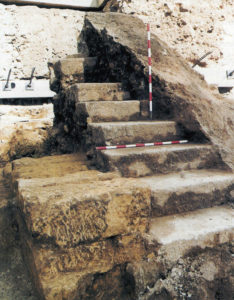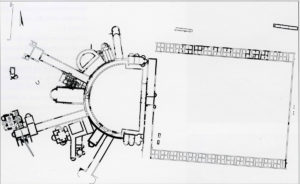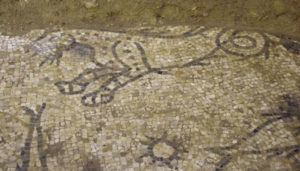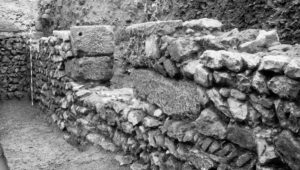
Public and Semi-Public Architecture

The great monumental complexes that characterized Colonia Patricia disappeared slowly and progressively due to an accumulation of not always well-known factors.
Apart from the abandonment and looting of the circus at the end of the second century (for unknown reasons), the key moment in the evolution of the public and semi-public architecture of the Roman Cordova was between the middle of the third century and the beginning of the fourth. In just half a century, the theater, the upper terrace of the religious complex of Claudio Marcelo’s street, the forum novum, and the amphitheater were destroyed. The combination of factors such as the demand for stone and marble, the construction of the Cercadilla complex, the effects of a possible earthquake in the 50s and 60s of the third century, the weakening of the imperial cult, or the minor interest in the religious architecture from the Severian period, could explain such abandonments.

Due to its special importance, the building of the suburban complex of Cercadilla stands at the end of the III-early fourth century. Although its original functionality continues to be subject of debate, the most widespread hypothesis is that at first, or a few years after its construction, it would function as the seat of the vicarius hispaniarum, whose capital could fall temporarily in Corduba.

Unlike the public spectacles buildings (theater, amphitheater and circus), the thermal establishments remained in use for a longer time, since their disuse must have taken place throughout the fifth century. This prolonged period of life is extendable to others buildings such as the colonial forum (which continued to receive honorary pedestals in the 50s-60s of the fourth century), or the hypothetical port complex, which was reconverted into the late antique power center of the city from the fourth to fifth centuries.

Finally, some buildings of possible public or semi-public use have been dated in the sixth-seventh centuries. However its exact functionality could not have been determined.
Bibliography
APARICIO L.; VENTURA, A. (1996): “Flamen provincial documentado en Córdoba y nuevos datos sobre el Foro de la Colonia Patricia”, Anales de Arqueología Cordobesa, nº 7, 251-264.
CARRASCO, I. (2001): “Intervención Arqueológica de Urgencia en un solar sito en calle Góngora número 13, esquina a calle Teniente Braulio Laportilla, (Córdoba)”, Anuario Arqueológico de Andalucía 1997, vol. III, Sevilla, 199-208.
CARRASCO, I. et alii (2003): “Informe-Memoria de la Intervención Arqueológica de Urgencia en el Paseo de la Ribera (1999-2001). I. Sector de la Puerta del Puente”, Anuario Arqueológico de Andalucía 2000, vol. III, Sevilla, 283-298.
CASTRO, E.; CARRILLO, J. R. (2005): “Intervención Arqueológica de Urgencia en el patio occidental del colegio de Santa Victoria”, Anuario Arqueológico de Andalucía 2002, vol. III, Sevilla, 350-364.
FUERTES, Mª. C.; (2011): “El palacio imperial de Córdoba”, en Mª.D. BAENA, C. MÁRQUEZ y D. VAQUERIZO (eds.), Córdoba, reflejo de Roma. Catálogo de la exposición, Córdoba, 90-99.
GARCÍA, R.; CARRASCO, I. (2004): “Intervención Arqueológica de Urgencia en un solar sito en el número 5 de la calle Morería de Córdoba”, Anuario Arqueológico de Andalucía 2001, vol. III, Sevilla, 163-174.
GARRIGUET, J. A. (2002): El culto imperial en la Córdoba romana. Una aproximación arqueológica, Córdoba.
HIDALGO, R. (2014): “Aspetti dell’ interpretazione del complesso palatino di Cercadilla a Cordova”, en P. PENSABENE y C. SFAMENI (coords.), La villa restaurata e i nuovi studi sull´edilizia residenziale tardoantica, Bari, 533-542.
JIMÉNEZ, J. L.; RUIZ, Mª. D.; MORENO, M. (1996): “Nuevos avances en el conocimiento sobre el urbanismo de Colonia Patricia Corduba en el sector ocupado por el templo romano”, Anales de Arqueología Cordobesa, nº 7, 115-139.
LEÓN, A.; MURILLO, J. F. (2009): “El complejo civil tardoantiguo de Córdoba y su continuidad en el Alcázar Omeya”, Madrider Mitteilungen, nº 49, 323-335.
MONTERROSO, A. J. (2002a): “La secuencia estratigráfica. Evolución histórica del teatro de Colonia Patricia”, en A. VENTURA et alii (eds.), El teatro romano de Córdoba. Catálogo de la exposición, Córdoba, 133-146.
MONTERROSO, A. J. (2002b): “El edificio como cantera: historia de un saqueo”, en A. VENTURA et alii (eds.), El teatro romano de Córdoba. Catálogo de la exposición, Córdoba, 147-160.
MORENO, M.; GONZÁLEZ, M.L. (2001): “Intervención Arqueológica de Urgencia en la plaza de Maimónides, esquina c/ Cardenal Salazar de Córdoba”, Anuario Arqueológico de Andalucía 1997, vol. III, Sevilla, 163-171.
MURILLO, J.F. et alii (2010): “El área suburbana occidental de Córdoba a través de las excavaciones en el anfiteatro. Una visión diacrónica”, en D. VAQUERIZO y J.F. MURILLO (eds.), El anfiteatro romano de Córdoba y su entorno urbano. Análisis arqueológico (ss. I-XIII d.C.). Monografías de Arqueología Cordobesa, nº 19 vol. I, Córdoba, 99-310.
RUIZ BUENO, M.D. (2016): Topografía, imagen y evolución urbanística de la Córdoba clásica a la tardoantigua (ss. II-VII d.C.). Tesis Doctoral (inédita), Córdoba.
RUIZ NIETO, E. (2003): “Intervención Arqueológica de Urgencia en el Paseo de la Victoria, 17”, Anuario Arqueológico de Andalucía 2000, vol. III, Sevilla, 475-482.
TORRERAS, S.; VENTURA, A. (2011): “Una exedra con schola en Colonia Patricia”, en Mª.D. BAENA, C. MÁRQUEZ y D. VAQUERIZO (eds.), Córdoba, reflejo de Roma. Catálogo de la exposición, Córdoba, 68-77.

